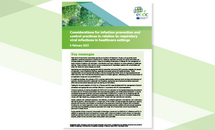Considerations for infection prevention and control practices in relation to respiratory viral infections in healthcare settings
High levels of community transmission and the co-circulation of respiratory viruses, such as severe acute respiratory syndrome coronavirus 2 (SARS-CoV-2), influenza, respiratory syncytial virus (RSV) and others can increase pressure on healthcare systems. These co-circulating viruses pose a challenge for the management of large numbers of patients with respiratory viral infections and have a tendency to cause outbreaks in healthcare settings.
Executive summary
Key messages
High levels of community transmission and the co-circulation of respiratory viruses, such as severe acute respiratory syndrome coronavirus 2 (SARS-CoV-2), influenza, respiratory syncytial virus (RSV) and others can increase pressure on healthcare systems. These co-circulating viruses pose a challenge for the management of large numbers of patients with respiratory viral infections and have a tendency to cause outbreaks in healthcare settings. These outbreaks often result in severe consequences for hospitalised patients with comorbidities and other risk factors for severe disease and death.
Maintaining and strengthening appropriate infection prevention and control (IPC) practices mitigates the spread of respiratory virus in healthcare facilities, especially during peak periods of hospital admission. Timely implementation of multi-layered interventions is the key to preventing further strain on hospital personnel and other resources. Such interventions should be based on a holistic approach, addressing risks from transmission of all respiratory viruses and not just SARS-CoV-2.
In healthcare facilities, the mainstay of IPC comprises administrative measures (such as triage and placement of patients), standard precautions (especially hand hygiene), appropriate use of personal protective equipment (PPE) and environmental measures (such as cleaning and ventilation).
Testing for the early detection of COVID-19, influenza and RSV cases facilitates both the management of patient admissions and appropriate room and bed allocation in accordance with IPC recommendations.
Universal screening, by testing all patients for SARS-CoV-2 on admission to the hospital irrespective of symptoms to reduce the risk of onward transmission from asymptomatic patients, has limited additional benefit. It may be considered during periods of high community transmission of SARS-CoV-2, in particular by targeting high-risk vulnerable groups (e.g. patients admitted to oncology, transplantation units, etc.) or in the event of emerging viruses with high impact (e.g. emerging SARS-CoV-2 variants with high morbidity and mortality).
Ideally, patients with confirmed respiratory viral infection, or probable respiratory viral infection with confirmatory test results pending, should be placed in a single room. If the number of cases exceeds the single-room capacity, patients with the same viral infection can be placed in the same room (cohorting). Patients with co-infections involving two (or more) respiratory viruses, immunocompromised patients, patients with pronounced symptoms and those requiring bedside procedures associated with a high risk of transmission should be prioritised for placement in single rooms.
During periods of high community transmission of respiratory viruses such as SARS-CoV-2, influenza and RSV, in addition to appropriate hand and respiratory hygiene, staff, visitors and patients in both primary and secondary healthcare settings should be advised to wear medical face masks (universal masking) in common areas of the hospital, patient rooms and other areas where patient care is provided.
Alternatively, during periods of high community transmission, healthcare workers in contact with patients should wear a medical face mask during all routine patient care (targeted clinical masking). Universal and targeted clinical masking can be discontinued when the period of high community transmission is over.
Decisions on implementation of universal or targeted clinical masking should take into account the expected benefit, as well as the burden on resources, staff, patients and visitors.
Healthcare facilities should ensure that PPE is available and appropriately used to safeguard staff providing patient care.
A risk assessment should be conducted to support appropriate selection of PPE. It is recommended that healthcare workers interacting with patients who have viral respiratory infections, without close proximity or long exposure to the patient, should wear a medical face mask, as a minimum. For prolonged contact in close proximity to the patient, including the performance of high-risk procedures, a well-fitted respirator (see ‘Definitions’) and eye protection are recommended. Gloves and a long-sleeve gown are recommended when there is a risk of exposure to body fluids and in settings where there is a high risk of exposure to respiratory viruses, such as when performing procedures with a high risk of transmission (also referred to as ‘aerosol-generating procedures’ - AGPs). If gloves and gowns are used, these should always be changed after contact with each individual patient.
In hospital rooms, it is recommended that floors should be cleaned regularly and that frequently-touched surfaces are disinfected using hospital disinfectants active against viruses. Ventilation is a key environmental measure for the prevention of respiratory viral infections in healthcare and other settings. The minimum number of air exchanges per hour, in accordance with national or hospital regulations, should be always ensured.
The decision to discontinue transmission-based precautions should be based on the time since symptom onset, the resolution of symptoms and other factors, such as the severity of disease, possible immunodeficiency and microbiological test results.
Download




